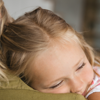A recent Mental Health of Children and Young People (MHCYP) survey provided a rare resource on what the pandemic has meant for children.
The study showed that the increase in probable mental health problems reported in adults also affected 5–16 year olds in England, with the incidence rising from 10·8% in 2017 to 16·0% in July 2020.
More than a quarter of children (aged 5–16 years) and young people (aged 17–22) reported disrupted sleep and one in ten (5·4% of children and 13·8% of young people) often or always felt lonely.
A certain amount of anxiety for children is normal and managed by them with a little support from carers. It is usually limited to specific situations. A child with high level anxiety is likely to over estimate threat or danger.
Anxiety becomes a problem when the child requires constant reassurance from carers and it impacts on their ability to sleep, learn, make friends and have fun.
When offering reassurance to an anxious child, it is important to remember that helping a child to develop self- reliance to face fears will be more effective in the long term than cuddles and soft words alone. Anxious children need help to develop skills to manage fears and tolerate life’s uncertainties.
Anxiety affects children and adults in a cognitive, physiological and behavioural way. It is therefore important to help children notice what is going on in their mind, body and with their behaviour when they are anxious.
Anxious thoughts
Children can be helped to notice the difference between real thoughts and worry thoughts.
There is a worry that you can do something about and a worry that is a ‘what if’ thought. ‘. Adults can help children to think about a worry that they can do something about. For example:-
Pete worried that he would be late meeting his friends in the morning and would have to travel to school on the tube by himself.
His mum thought with Pete about how he could stop this from happening. Pete decided to pack his bag at night so he would be on time. His mum also thought with Pete about what would happen if his worry came true. To take away the fear of having to travel alone, Pete and Mum decided to do a test trip to school on Saturday. Pete went by himself but knew that mum would follow and sit in an adjoining carriage.
Pete’s mum helped Pete to break his worry down into small manageable steps. She did not tell him how to solve his worry but encouraged him to think for himself. With Mum’s support, Pete managed to conquer his fear and discovered that he could do the journey by himself.
A ‘what if’ worry can be more difficult to control. ‘What if’ thoughts often go with children who have big imaginations. For example,
Tim worried at night when he heard helicopters going over his home. His greatest fear was a terrorist attack. Pete spoke to his counsellor about this fear.
Together, they thought about the many reasons helicopters fly over London and Pete did his own research on this at home. They noticed that Pete’s mind took him to a catastrophic scenario which was unlikely to happen. Pete learnt to stop his brain going to worst case scenarios, instead he used the information he had found out and imagined the helicopter was doing a traffic report.
Children can be helped to notice how their mind works. They can learn to replace anxious self- talk with calming self- talk as they catch a worry thought and stop it before it grows.
Drawing a picture of what is making a child anxious is sometimes more helpful than talking. Drawing helps children to process strong emotions. The child can tell you about their drawing which can be easier than talking about their worry.
Helping children choose what to do with the drawing helps them control a worry. Do they want to keep it, give it to a trusted adult, scribble over it, tear it, stamp on it or throw it away? Can they draw another picture about when the worry went away? What made the worry go away?
Some children respond well to the idea of giving a worry to a worry monsters. Worry monsters can be home made from boxes with a slit for a mouth to post worries or can be shop bought. The more they feed the monster with worries the bigger he will get. The less they feed him the smaller he will get and the smaller their worries will become.
Children can also draw a worry monster. Can they draw themselves beside the monster, are they bigger or smaller than the worry monster? As they begin to take control of their worry, they will get bigger and the monster will become smaller. One day he may disappear.
Older children can write about their worry in a journal. They could choose to talk about it or keep it private. Some older children find it easier to message a parent or carer on a phone with their worry rather than speak about it.
Feelings in the body
When children are anxious, they can be helped by asking them how their worry is making their body feel. Let them tell you rather than suggest ideas to them. Do they say their tummy aches or feels funny? Do they have thoughts in their brain that never stop or a head ache? do their limbs go stiff ? Learning to relax the body’s muscle system allows children to control the escalation of physical symptoms.
Breathing:- Hold a hand out and trace around each finger. Breathe in up the finger, hold your breath, breathe out down your finger. Repeat five times.
Learn to relax body muscles. :- Make yourself a stiff as a robot, slowly change each part of your body into a floppy rag doll.
Some children find the book ‘Sitting Still Like a Frog. Mindful Exercises for kids by Eline Snel helpful. It comes with a CD and is suitable for children aged 5 to 12. It is an introduction to mindful exercises for children. It can help them to calm down, fall asleep more easily and alleviate worry.
Children can also put together a calm down box to use when they are feeling anxious. It can contain bubbles to blow, playdoh or putty to feel, fidget toys, something to smell such as lavender and something to colour.
Behaviour
Children can be helped to notice how their thoughts lead to behaviour. Are they tearful? quiet? angry? Noticing behaviour that children display when they are anxious helps them to think about which ones are helpful and which ones make feelings worse. Children can learn to take control of their behaviour by finding activities that calm and self soothe.
A good cry can be healing. Angry feelings can be let out in a safe way such as punching or kicking a pillow. Going for a walk or another form of physical activity such as skipping or jumping on a trampoline can work wonders. If a child wants to be alone, reassurance should be given that you understand their wish but are available if they want you.
Managing your own anxious mind
Children pick up ways adults close to them manage anxiety. During this pandemic, dealing with your own anxious thoughts in a healthy way models to children how to react in stressful times and helps them feel secure.
There are many excellent books written to help children understand and manage anxious feelings. Some I would recommend are:-
- Starving the Anxiety Gremlin. A Cognitive Behavioural Therapy Workbook on Anxiety Management for Children Aged 5 to 9 by Kate Collins-Donnelly. Jessica Kingsley Publishers.
- Starving the Anxiety Gremlin. A Cognitive Behavioural Therapy Workbook on Anxiety Management for Young People (Aged 9+). By Kate Collins Donnelly. Jessica Kingsley Publishers.
- No Worries. An Activity Book for Young People who sometimes feel Anxious or Stressed. (Aged 7+) Lily Murray. Studio Press.
- Don’t Worry, Be Happy A Child’s Guide to Overcoming Anxiety. Poppy O’Neill. (Aged 7-11) Summersdale Publishers Ltd.
- The Unworry Book. A book to calm your mind by Alice James (Aged 8+). Usborne.



